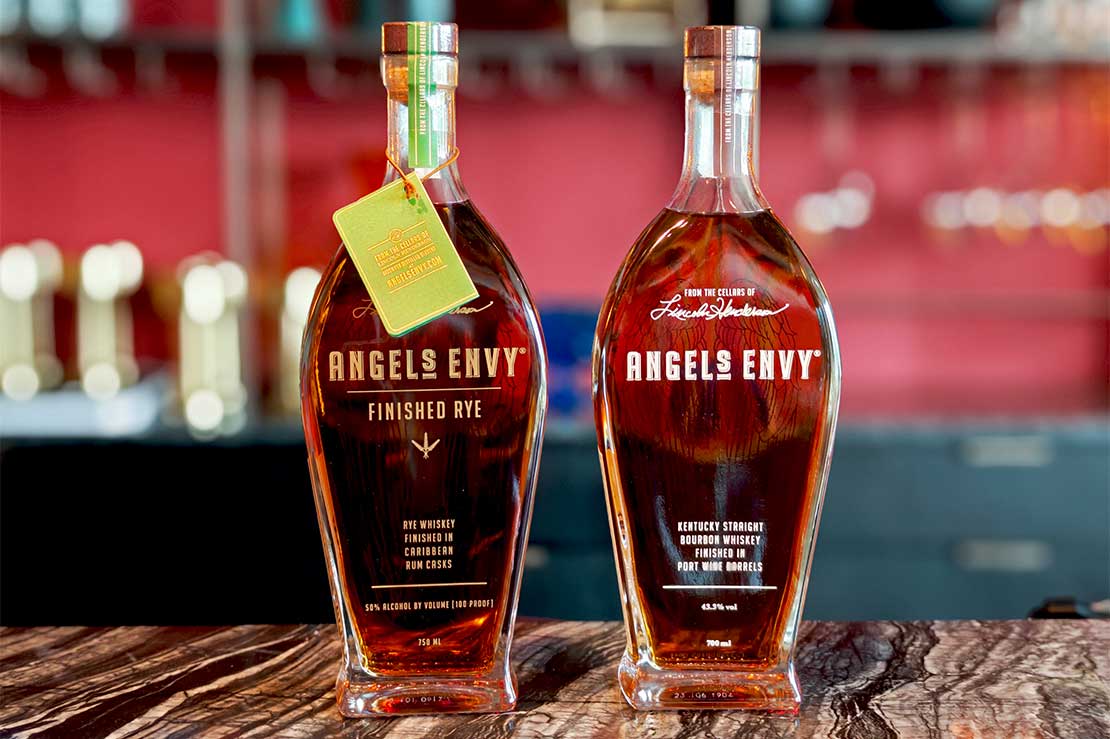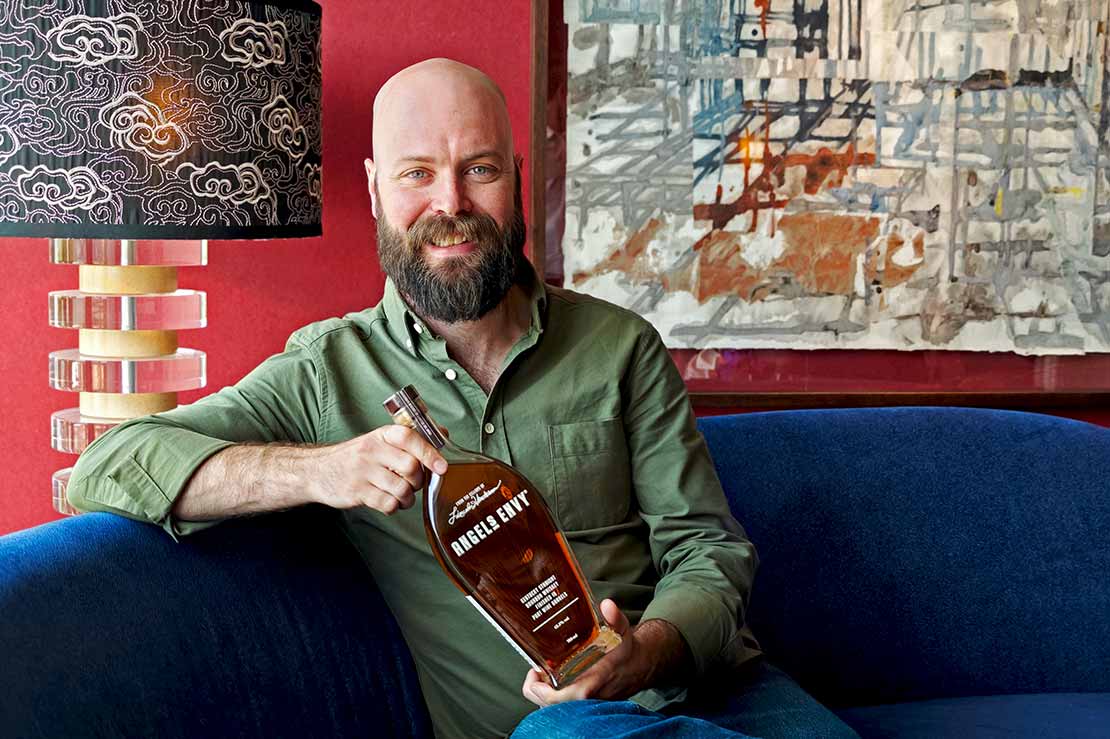In the bright afternoon at MO Bar, we talked candidly over a coffee with Owen Martin, master distiller for Angel’s Envy, about his career decision, the preferences of American whiskey drinkers compared to those from the rest of the world, and craft beers.
1. What led you to transition from craft beer to whiskey, and how has your journey through distilleries shaped your career in the whisky industry?
I initially moved to Scotland to pursue a master's in brewing and distilling science, with a focus on craft beer. However, living in Scotland, where whisky culture is so deeply rooted, I became fascinated with whisky production, which starts similarly to beer but without the hops. During my master's thesis at Glenkinchie Distillery, I shifted from engineering to whisky making, and that experience solidified my decision to enter the whisky industry. After returning to the U.S., connections I made in Scotland led me to work in distilleries in Arkansas and Colorado before eventually joining Angel's Envy. Throughout my career, I've seen the industry evolve, with a growing focus on craftsmanship and consumer interest in the technical details of production, which aligns perfectly with my craft-driven approach.
2. I know this is your first time in Asia, but is Angel’s Envy planning any special releases for the Asian market?
While it's early for me to fully understand the Asian market, I’ve noticed Singapore's strong preference for single malts, which has sparked the idea of creating peated whiskies. Kentucky, where I’ve only been for two years, has more of a bourbon versus Scotch mentality, which isn’t really my approach. Personally, I love peated whiskies and Scotch – living in Scotland made me a fan – so I’d love to do our own twist on a peated whiskey. It’s still in the works, but I can see it resonating more in places like the U.K. and certainly Asia, rather than in the U.S. That’s something that might be down the line, though. We’re just beginning to explore it.
3. Can you share more about the Kentucky Straight Bourbon Whiskey Finished in Port Wine Barrels?
The whiskey we’re introducing today is finished in Ruby Port barrels, which has become a signature of Angel’s Envy. While both European and American consumers seek authenticity and provenance in their whiskies, their preferences diverge. European drinkers often focus on age statements and finishing techniques, while American consumers are more drawn to unadulterated, single-cask, small-batch whiskies. What excites me about Angel’s Envy is how we bridge these worlds by using a finishing cask, like Ruby Port, to appeal to a global audience, while still embracing the American whiskey tradition.
4. Do you find that American whiskey drinkers differ from those in the rest of the world?
While drinkers worldwide are united in their appreciation for craftsmanship and detail, their preferences are expressed differently. In the U.S., there’s a strong focus on single-barrel and cask strength whiskies, emphasising the pure, straight-from-the-barrel experience. American whiskey drinkers tend to favour oak-forward flavours, like caramel, vanilla, and toasted coconut, due to the use of virgin oak barrels. In contrast, whisky enthusiasts from places like Scotland, Ireland, and Taiwan are more interested in provenance, terroir, and age statements, often favouring grain and distillate flavours over the bold oak characteristics of American whiskies.
5. Do you believe the distinct flavour profile of American whiskey is influenced by early regulations?
Absolutely. The regulation mandating the use of new, virgin oak barrels for bourbon wasn’t initially focused on flavour enhancement; it was largely a lobbying effort by coopers to support the industry. As a result, American whiskey developed a profile rich in oak flavours like caramel, vanilla, and toasted coconut, which are derived from the toasted or charred barrels. This flavour expectation has now extended internationally as bourbon's popularity grows, contrasting with Scotch's focus on grain and aging nuances. Ultimately, it reflects a different expression of whiskey rather than a judgment on quality.

Fron left: Angel's Envy Rye Whiskey Finished in Caribbean Rum Casks; Kentucky Straight Bourbon Whiskey Finished in Port Wine Barrels. [Photo: Kim Choong]
6. Are there challenges in maintaining the supply of new virgin oak barrels for bourbon, especially considering the sustainability of the ecosystem?
There was a moment, particularly during COVID when bottle sales skyrocketed, everyone was drinking at home, trading up, and had more disposable income for quality whiskey. After COVID, there was concern about the supply of oak barrels due to a surge in demand as consumers flocked back to bars. However, that concern has stabilised. Legally, bourbon must be aged in new virgin oak barrels, but being part of Bacardi allows us to maximise the use of these barrels by sending them to Scotland, Ireland, or Puerto Rico for further ageing before bringing them back for reuse. Additionally, we run a tree planting program in collaboration with the University of Kentucky to ensure sustainable forestry practices, as coopers are equally invested in preventing oak shortages. This collaborative approach supports the future of the bourbon industry, especially as more distilling programmes emerge in the U.S., promoting technical expertise and sustainable practices across the board.
7. How do you view the relationship between bourbon and Scotch whisky, especially considering Bacardi owns both types of spirits?
I see bourbon and Scotch whisky as complementary rather than competitive, particularly from a bartender's perspective. Bourbon is often viewed as more accessible for cocktails, fitting seamlessly into classic drinks like Old Fashioneds and Manhattans, while Scotch is typically enjoyed neat or in highballs. Although there is some competition between whiskey categories, it's healthy for consumers to appreciate both. As a whiskey maker, I respect the craftsmanship in both worlds and believe there’s much to learn from Scotch techniques, such as cask finishing, which we’ve integrated into our bourbon. Instead of seeing Scotch as a rival, I view it as an opportunity for collaboration and shared learning in the whiskey industry.
8. What is your perspective on whisky collecting, especially with the current trend, and do you prefer collectors who open their bottles or those who see whisky as an investment?
I encourage collectors to open their bottles and enjoy them! While I respect those who collect for investment purposes, my focus is on the joy of sharing and tasting whiskey. In my own collection, I have only one or two bottles that I haven’t opened for sentimental reasons; everything else is available for sharing. I believe that discussing the flavours and craft of whiskey happens best when the bottles are open. I prefer engaging with those who appreciate whiskey for its experience and artistry rather than solely for investment, as the real enjoyment lies in sharing and exploring what’s inside the bottle together.
9. Do you ever pair beer and whiskey together, and what has been your experience with such collaborations?
Shortly after joining Angel’s Envy, I collaborated with a nearby brewery to create a unique beer that complements a glass of Angel’s Envy. So instead of the typical bourbon barrel-aged beer, which has been done a lot, I wanted to try something different. So, we brewed a beer specifically to complement a glass of Angel’s Envy, and they could be served together. We also use their house ale yeast for our bourbon fermentation, which resulted in something very different. We let the fermentation go for a week instead of the usual three days. The downside to experimenting with new yeasts or grains though, is that it’s a long process. If I’m working with finishing casks, I can pair those with five or ten-year-old bourbon and have a new product ready within a year. But starting from scratch with a new yeast or grain bill means we have to wait. That ale yeast experiment is only a year and a half old, and I won’t see a bottle for another five years!
10. What is your favourite beer, and who would you want to share it with?
My go-to beer is Two Hearted Ale from Bell’s Brewery, a 7% IPA that I enjoy after a long day. However, if I plan to have multiple drinks, I lean toward lighter options like pilsners or lagers. One brewery I admire is Bierstadt Lagerhaus in Colorado, known for being a “brewer’s brewery” and a favourite spot for industry professionals at events like the Great American Beer Festival. If I could share a beer, I’d love to drink it with the person who crafted it, whether it’s beer or whiskey, as it would be a fantastic way to geek out over the details and the process behind the drink.
- T -
